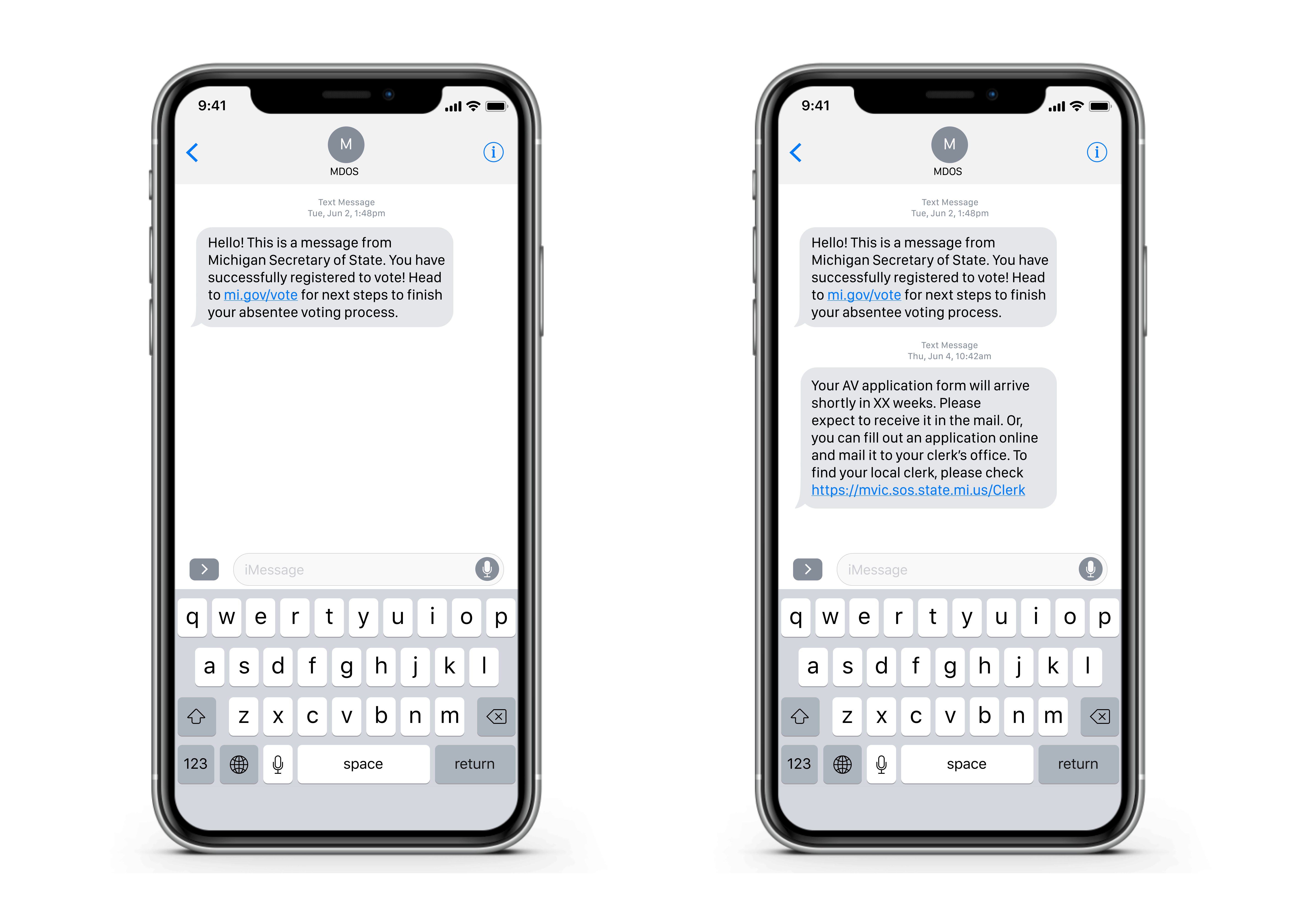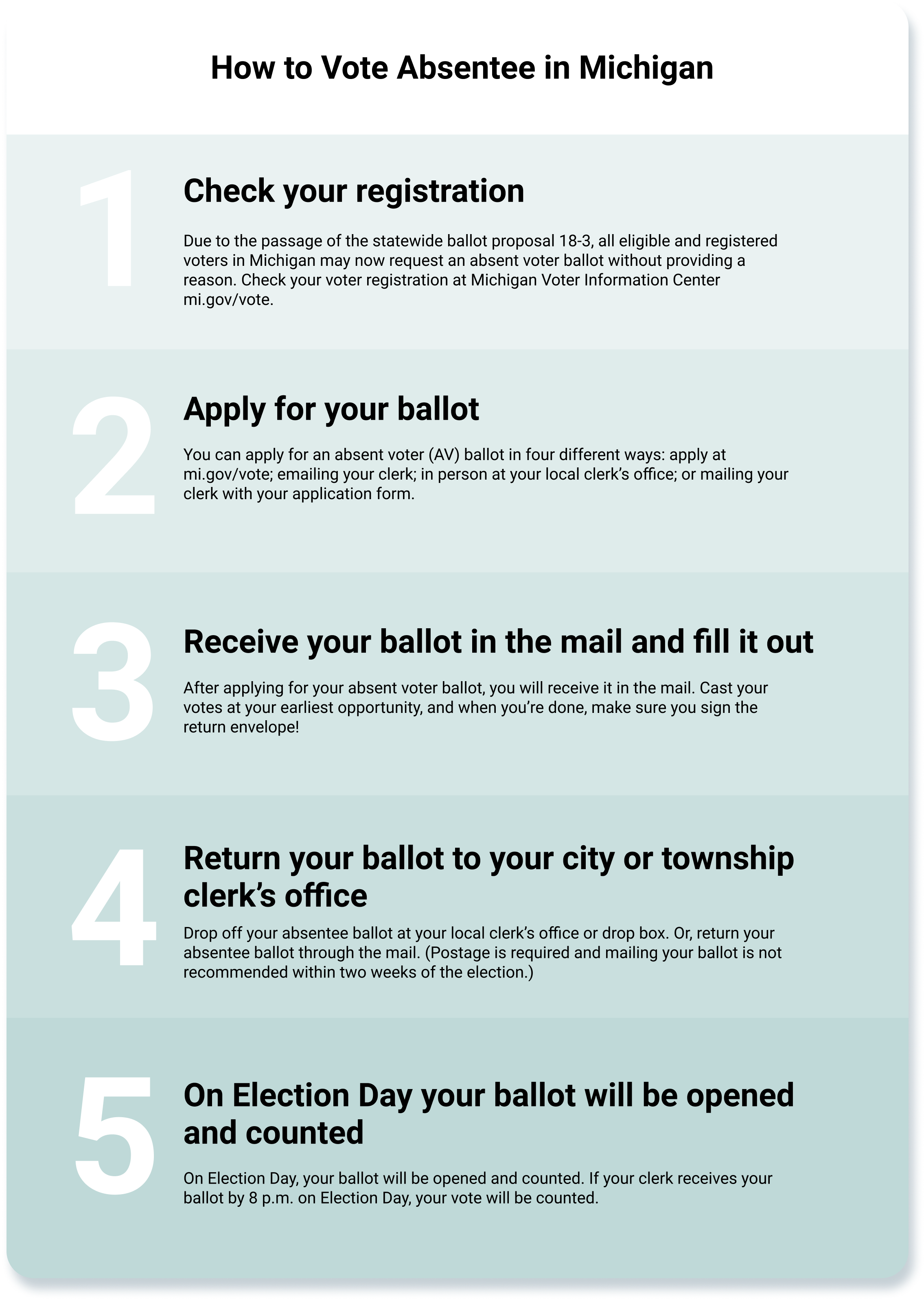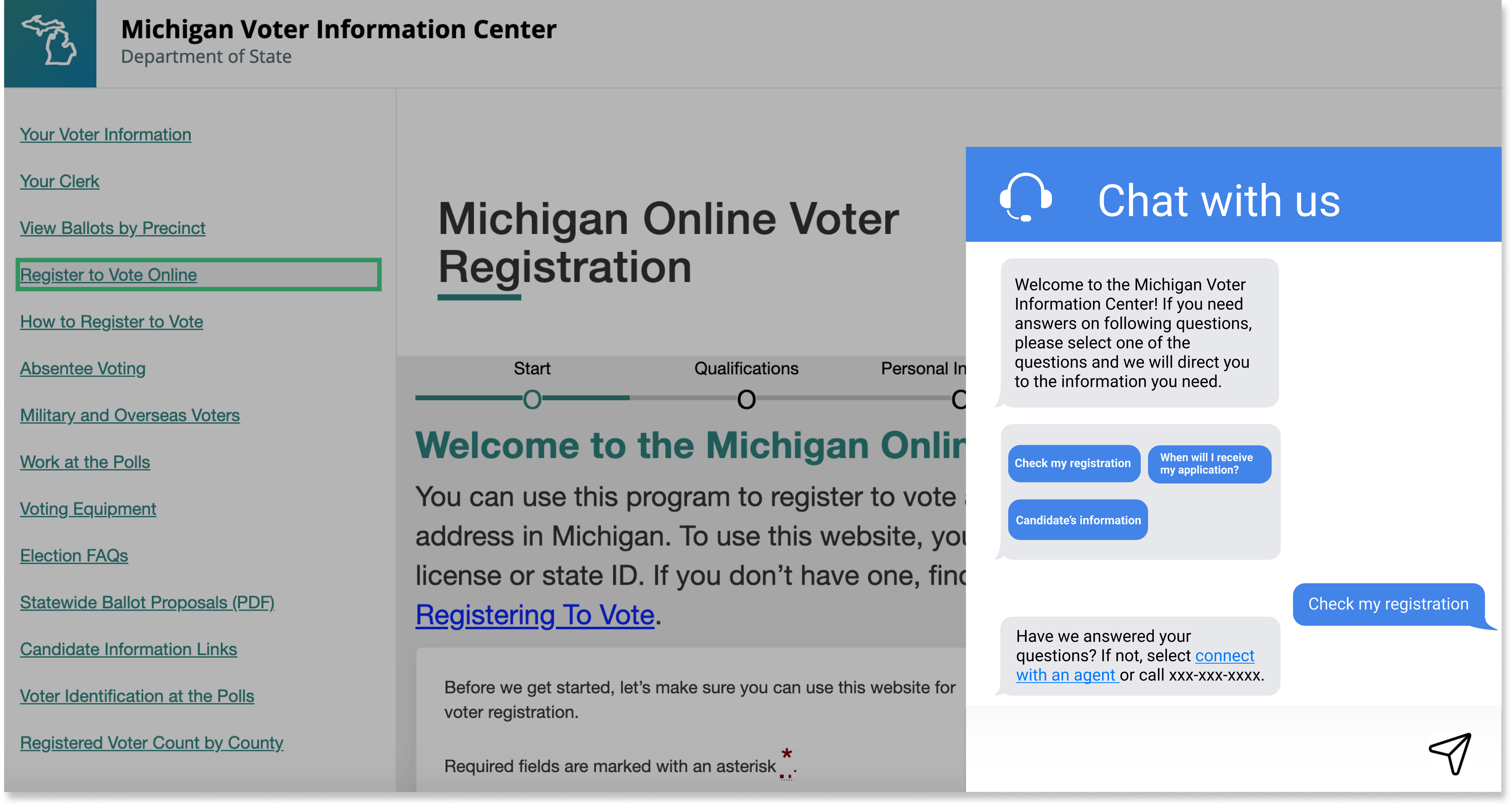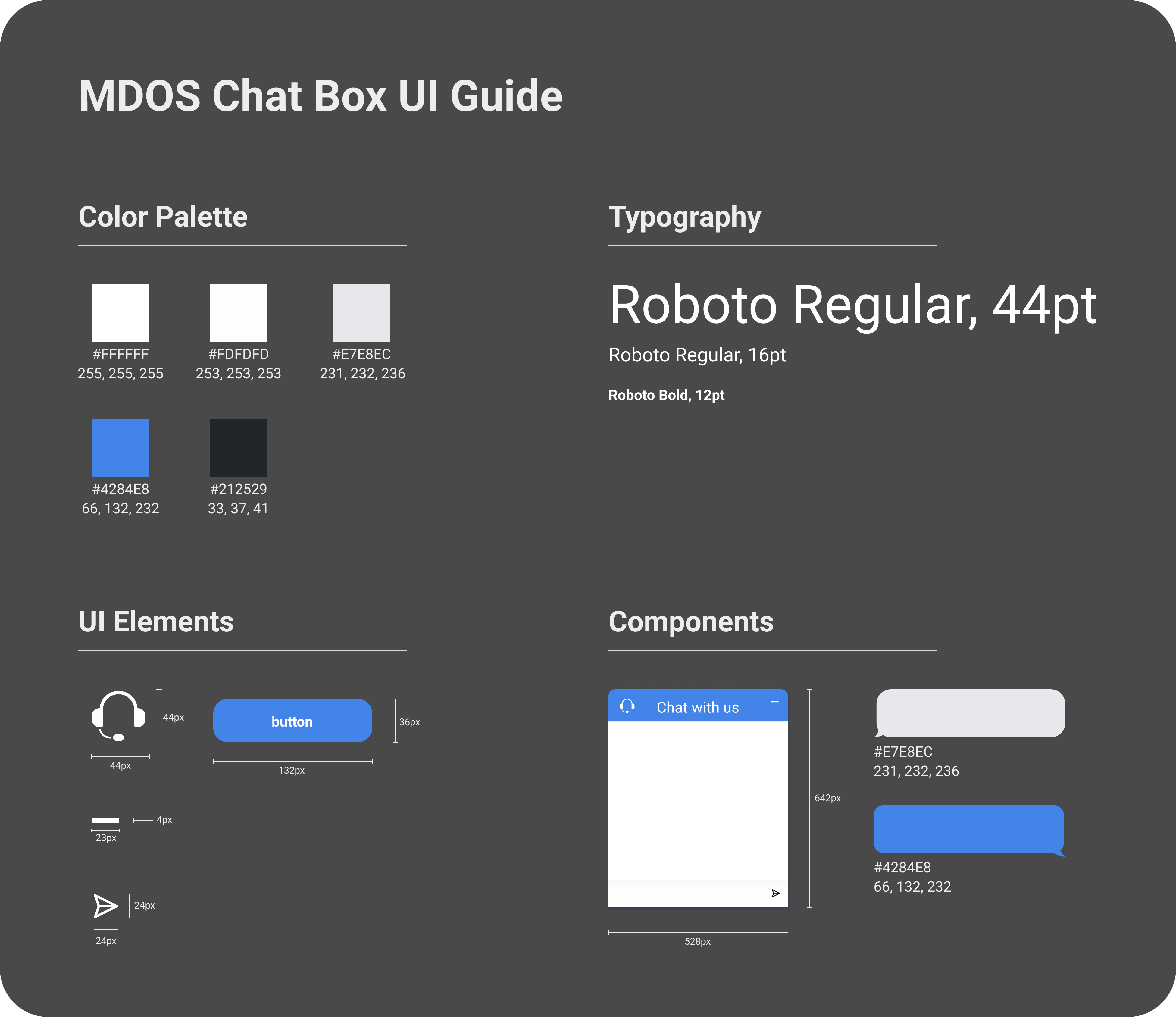Michigan Department of State

The Michigan Department of State approached our team with the goal of increasing accessibility to absentee ballot voter information for young voters in Michigan. Specifically, MDOS wanted us to think about how to reach young populations that are historically difficult to reach.
Duration: May 26, 2020 - Aug 14, 2020
Team and role: Citizen Interaction Design Summer Fellows; UX Design, UX Research
Type: Client Project
Skills Used: Semi-structured Interviews, Affinity Diagramming, Comparative Analysis, Background Research, Research Synthesis, Rapid Ideation, Participatory Design, Prototyping, Design Justice

The Problem
The problem we addressed was broadly related to voting via absentee ballot in Michigan. Proposal 3 allows no-excuse absentee voting and same-day voter registration. Because of COVID-19, the Michigan Secretary of State sent out absentee ballot applications to all registered voters in Michigan, which increased the number of processing work carried by local clerks’ offices, who were already stretched thin because of social distancing guidelines. Specifically, we were interested in helping younger generations get access to the information they need in order to apply/receive/submit absentee ballots.
Project Objectives
Below are the primary objectives we worked toward throughout the duration of the project.
- Reduce misinformation surrounding absentee ballots. E.g., people thinking they’re only counted if the clerk office “likes” the vote, people thinking they’re only counted when the race is close.
- Point college students towards a centralized and reputable source of information where they can find information about absentee voting.
- Learn about any barriers this population will encounter and plan a way for them to circumnavigate these barriers.
- Optimize the information flow of local clerks processing absentee ballots and continue increasing student voter turnout.

RESEARCH
Stakeholder Interviews
The team was aware that there was a lot for us to learn about the voting process in Michigan, both from the bureaucratic side and the voter's side. To get a firmer grasp of the problem, we began interviewing city and township clerks about their local voting processes.
Fun fact: Michigan is the only state in the U.S. whose voting is administered on a city and township level. Most other states in the U.S. administer voting on a county level. This means Michigan makes up about 25% of the entire country's voting entities with its 1,500+ cities and townships running elections.
What we wanted to know from city and township clerks:
- What are clerks' pain points or frustrations surrounding the absentee voting process during the pandemic?
- How did they respond to those frustrations?
- What sort of interactions do they have with voters, including college students?
After forming our research questions I created an interview protocol ↗ that we could follow when conducting the interviews with clerks. After each interview we transcribed the conversation. Myself and another team member worked on an affinity diagram to discover common insights among the clerks.

City and township clerk interview affinity board. Download a PDF ↗
Upon completing our affinity analysis, we came across several helpful insights that influenced the rest of our work on the project:
- Most clerks think that the absentee voting method benefits voters.
- However, due to the pandemic and the Michigan prop 3 change, clerks were concerned that a surge in absentee ballot processing would increase an already heavy workload.
- Clerks faced numerous challenges hiring poll workers in their precincts, largely due to social distancing guidelines and limitations.
- Leading up to the 2020 presidential election, much of the clerks' time was spent taking calls and responding to emails regarding questions about absentee voting.
- Clerks all had unique methods for informing the public about absentee voting in their city or township. These methods included creating informational videos, using social media channels to interact with voters (YouTube, facebook forums, etc.) and some even held in-person lectures.
RESEARCH
Defining Our Target Audience
Learning about the clerks' perspectives on absentee voting was essential to our project, but we still needed to figure out who exactly we were designing for. In order to align our target audience with our client's needs, we began to research college students. This lead us to conduct secondary interviews with organizations focused on college student voter outreach. Additionally, we conducted background research to get a sense of college students' perceptions around absentee voting.

Affinity board of research on college student voters. Download a PDF ↗
Everyone on the team generated sticky notes with the information they gathered. We organized that information into an affinity diagram to explore common themes. Our high level insights are as follows:
- College students are unaware of reputable resources in relation to absentee voting and voting in general—in fact, they often face the problem of information overload. This might result in the outcome that students are not very familiar with voting procedures and process in order to vote or vote absentee.
- There are some specific barriers that might prevent college students from voting absentee. Those barriers include lack of access to printers, postage, and internet access. Our research shows that the pandemic has exacerbated many of these barriers.
- Social media is the main channel through which students receive information.
- The majority of students believe that they can make a difference in voting and encouraging others to vote. However, students from families of lower social economic status might lack equivalent education and access to information they need. Additionally, they are more prone to distrust the voting system.
- When it comes to encouraging younger college students to vote, community colleges lack resources and funding to encourage civic engagement. For example, many community colleges don't have a dedicated campus representative or centralized office to increase students' turnout compared to traditional four year universities.
IDEATION
Exploring the Problem Space
While researching college students, we noticed that community college students had fewer resources available to them compared to students at a four year university. Furthermore, we saw that not only do community college students have a much lower voter turnout rate than their university counterparts, but they tend to be more passive about seeking voter information. We decided that it would be wise to design a solution for this population that we saw as underserved. We narrowed down our target audience as community college students between the ages of 18 and 25, which aligned with our client's goal of designing for harder-to-reach younger voters.
At this point, I thought it would be wise to generate a wide array of ideas based on the information we gathered. Using the rapid ideation method, I facilitated an open-ended design brainstorm session with two other group mates to quickly generate ideas.

Brainstorm session for design ideas. Download a PDF ↗
After narrowing down some key design ideas, I facilitated a whiteboarding session to focus on the pros and cons of each design.

Whiteboard session for design pros and cons. Download a PDF ↗
We arrived at four solutions to consider:
- A volunteer voter hotline/chat
- A guide to the website mi.gov/vote
- A compendium of voter resources that has been vetted for reliability and accuracy of information
- A tool to help community college students sign up to count ballots or work at precincts
We arrived at these four solutions because 1) we believed that they could be prototyped by the end of our program and 2) we believed that they were realistic solutions given the limited resources we were working with.
IDEATION
Comparative Analysis
Once we had a strong understanding of the kinds of designs we were thinking of prototyping, I conducted a comparative analysis to observe the strengths and weaknesses of other organizations' similar technologies. Through assessing what else was out there, I was able to synthesize my findings and quickly point to features that were lacking elsewhere or features that we should build on. I used the insights gathered here to rationalize our design decisions later in the process.
Key Takeaways
- Many resources fail to acknowledge students' unique needs when it comes to voting (and voting absentee).
- Many resources do not organize voter guidance by state. This means if a student in Michigan was looking for voting resources on one of these websites, they may not find information that applies to them. Even worse, they may be left confused and frustrated about how to proceed.
- While all services do include the documents needed to vote absentee (such as absent voter (AV) ballot applications), much digging is required to find them. Voters may benefit from an easier way to find these documents.

Comparative analysis of various tools and sources for voters
DESIGN
Refining Our Problem Statement and Participatory Design
Once we narrowed our scope to community college students, we wanted to learn about their absentee voting experience and knowledge in more detail. We reached out to community partners involved in community college student recruitment and designed a survey to send to student bodies at various different community colleges in Southeast Michigan. To our surprise, we were unable to successfully send out our survey. Administrators of the community colleges we reached out to were uninterested in sending our survey to their students without an IRB approval.
Because our team only had a few weeks left before our project deadline, we decided to adjust our target audience to university students between ages 18 and 25 who are eligible to vote. We refined our problem statement once again and landed on:
“How might we leverage information from existing trustworthy platforms to help college students answer questions around absentee voting and help them successfully submit the ballot?”
From the beginning of the project, our team's intention was to involve the community for which we were designing in the design process. In order to co-design with our target audience, we put together a participatory design protocol ↗ for virtual PD sessions. Our research questions for the virtual PD sessions were as follows:
- What are college students’ perceptions about voting absentee?
- What is their main confusion about the process?
- Where do they go when they have questions about absentee voting?
- What do they think about our design concepts?
Additionally, after more conversations and considerations about our original solutions, we altered some of our solutions and wanted to find out what our PD session participants thought of them. The solutions we presented to our participants were:
- A voter hotline for answering student voters' questions
- A chat box built into the MDOS website
- A student voter guide available on MDOS's website and elsewhere (e.g. social media)
- An SMS service texting confirmation of updates throughout the absentee voting process
We decided that tapping into our network was the best way to ensure a relatively high response rate. We emailed the UMSI listserv to recruit participants. Another teammate and I conducted the participatory design sessions together.

Whiteboard for participatory design activities. Download a PDF ↗
DESIGN & ITERATION
Distilling Data
After each participatory design session, myself and another group member distilled our findings in excel using the Elito Method. We chose this method because it offered a way to quickly articulate and justify the value of our co-designs in a way that would meet our client's needs.

Snapshot of our Elito analysis based on our participatory design sessions
DESIGN
Findings and Recommendations
Below are our three key findings, all of which informed our recommendations to the Michigan Department of State:
Finding 1: While the majority of the students we interviewed believe the process of absentee voting is as trustworthy as in-person voting, two of the participants expressed some concerns they had about whether their ballots would arrive on time. In addition, there seems to be common questions around when and whether their votes will eventually be counted. Participants indicated that they would have liked a notification for when their ballots had been received and counted. Furthermore, all students we interviewed expressed the desire to receive confirmation messages from the state about almost every step of the absentee voting process.
Recommendation 1: We recommended providing confirmation texts from the SOS to indicate when voters (including university students) have successfully registered, submitted their application, and cast their ballots. In addition, the confirmation would also include that the ballot has been counted for this election.

SMS Mockup 1 (left): An initial message from MDOS lets a voter know they're registered in Michigan.
SMS Mockup 2 (right): A follow up message tells the voter that an absentee ballot application has been sent to them. The message informs the voter other ways they can submit an application.

SMS Mockup 3 (left): A new message notifies the voter that their local clerk has received their absent voter (AV) application. After receiving, filling out, and sending their ballot, MDOS texts the voter that their absentee ballot has been received.
SMS Mockup 4 (right): MDOS texts the voter with confirmation that their absentee ballot has been processed. They offer additional guidance on how the voter can change their vote before the election, if they wish.
Finding 2: Students are not familiar with the absentee voting process—especially during registration, submitting absentee ballot applications and casting the ballots themselves. Many students had questions regarding how long they should spend completing each step, and what to expect after they finish each step.
Recommendation 2: Based on the pain points we discovered throughout our research, we recommended adding our video and our "one-pager" student voter guide to the Secretary of State website in addition to other social media channels. The video and the one-pager list each step of the absentee voting process, with short explanations (timeline, where, how) that will help students successfully cast their absentee ballot.

A one-page document on how to vote absentee in Michigan
An animation of how to vote absentee in Michigan
Finding 3: Students prefer text-based communication. Most students stated that they will only call their local clerks if their questions are complex. Based on our participatory design sessions, students preferred using the chat box in the SOS website to directly ask questions, as opposed to texting a phone number, since the chat box allows them to stay on one platform while searching for voting information.
Recommendation 3: We recommended implementing a chat box function alongside a telephone hotline option to call the state officials for help. The chatbot would aim to answer a large majority of the most common voter questions, and could list scenarios in which students could call the hotline number when they have more complex or specific questions.

Web Mockup 1: A chat box built into the Michigan Voter Information Center (MVIC) website. The chat is meant to steer voters to the right resources when they have basic questions about absentee voting.

Web Mockup 2: If the voter cannot find the information they're looking for, or if they have a more specific question, they can call someone on the voter information hotline or connect with an agent via the chat.
REFLECTION
Client Feedback and Future Work
Our client was pleased with our recommendations, specifically regarding the multiple solutions we offered. They especially appreciated the video and the one-pager, as those showed a sensitivity to their immediate needs—the video and one-pager could be distributed on their website and social media right away at virtually no cost. They showed interest in the SMS service but expressed that due to the timing of the pandemic combined with a particularly tense presidential election cycle, they would not currently be able to dedicate time to implement that feature. Should they choose to explore that option in the future, we provided them with an overview ↗ of several different mass-SMS services and their rates.
Given more time with this project, I believe we could have benefited from conducting user tests of the website chat box and the mobile SMS services. While these tools were validated in part by our participatory design sessions, we would have liked to gather more concrete data surrounding the usability of each service. Additionally, tracking the analytics of the video and one-pager would have helped us refine their placement online to meet outreach goals.
DESIGN & DOCUMENTATION
Refining Designs and Interactions, UI Documentation
If we had more time with our project, I would have really enjoyed the opportunity to think more deeply about the interactions of some of our recommendations. For practice, I wanted to follow through on the tools we thought of and design an interaction for at least one of them. I designed a happy path for the chat box service. This way, I saw what a full (and ideal) interaction would be between the service and the user. Plus, this gave me a better sense of how the design might have to be programmed if it were passed off to a developer.
Additionally, I documented all of the UI elements of the design. The UI guide acts as a road map for developers when they begin to implement the designs as code, keeping the design system organized and easy to reference.

Interactive prototype sequence for MDOS chat box

Example interaction of a happy path using the MDOS chat box for checking voter registration

MDOS chat box UI guide
Reflections on Group Work During a Pandemic
- This project was unique in that our team and our assignment was formed a couple of months after COVID-19 halted life as we knew it in the United States. While I was ready to be creative and optimistic about my fully remote collaborative work, I knew that a virtual internship would come with its challenges. Throughout this project I learned that honesty with your collaborators, as well as being flexible and compassionate are essential for team wellness.
Reflections on My First Time Working in Civic Tech
- Understanding that working with government organizations often means designing within extreme budget and human resource limitations.
- This meant that I needed to think of a diverse array of designs to recommend to the client, ranging from zero budget solutions (an informational video) to solutions that require more time and resources (implementing a chat box function on the Secretary of State's website). Pitching multiple solutions opened up the possibility for our client to take advantage of the “lowest hanging fruit” options first, and begin planning for the longer term solutions down the line.
- My biggest takeaway from this project was the importance of linking research findings to design decisions. Allowing the research to guide our designs ensured that what we built would be valued by the people we were building it for.